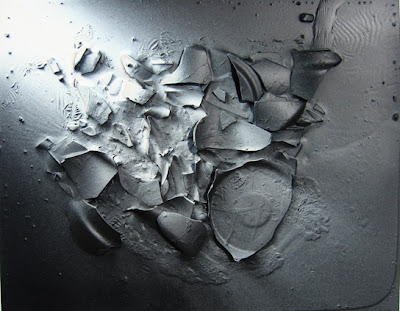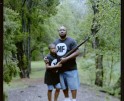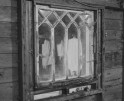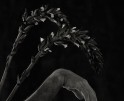Interview with Charlie Grosso of Baang and Burne Contemporary
The avenues of presenting, selling, and promoting photographs have changed and evolved over the last few years, partly due to the internet, the recession, and the digital revolution. Gallerists and photographers are looking for new ways and new markets in which to sell photography. Baang and Burne Contemporary is an innovative approach to the brick and mortar gallery and might be a template for the future of selling and showcasing art.
Baang and Burne Contemporary was created by artists and co-directors Kesha Bruce and Charlie Grosso, with the intent of providing an innovative way of bringing artists and art collectors together, especially newer collectors who are often deterred by the high intimidation factor at most contemporary art galleries. B+B will function as a roaming gallery presenting private exhibitions in NYC, LA, and Chicago. Their priority is to present and promote the work of a dynamic and diverse group of artists through cultivating relationships between collectors and artists. Baang and Burne Contemporary functions with complete transparency with the artists to further engage and encourage community building and to operate as a springboard for artists to take risks in launching new projects and introducing their work to international audiences.
On October 21st, B+B opens EveryDAY: Recent Artwork by Charlie Grosso and Todd Squires, an art event showcasing the recent works of New York artist Charlie Grosso and Los Angeles artist Todd Squires. Everyday is the second in a series of Baang and Burne’s signature one-night-only art events where artists and collectors are invited to attend small intimate gatherings where they have the chance to not only personally meet and talk with the artists, but to slip on a pair of white cotton art handling gloves and actually hold, touch, and admire works of art up close.
To attend one of their events, sign-up on the B+B contact page.
Image by Todd Squires
Artists Kesha Bruce and Charlie Grosso talk about the artist-gallery relationship and their new roles as directors of Baang and Burne Contemporary.
What makes Baang and Burne different from a traditional gallery?
KB: Well, in the strictest sense we aren’t a gallery at all. We don’t have a permanent location with four white walls, and we don’t host traditional art exhibitions that open on a certain date and close a month later. Our specialty is one night events. The work goes up, guests come, they see the work, they meet the artist, they eat great food, and spend a few hours chatting and mingling with other people who like art. The focus isn’t on the sale, but inevitably the art gets sold anyway. That’s the beauty of it.
CG: The goal of Baang and Burne is to create an environment where both collectors and curators could come and see the work and meet the artist. We want it to be intimate. We want it to be relaxed and casual, and focus on building relationships for the long term. We rejected the idea of having a permanent physical location because we wanted to create a business model based on flexibility and adoptability. Without the pressures of paying for a gallery space we can constantly reinvent and improve upon what we are doing.
What do you see as the drawback of the traditional gallery model?
KB: The biggest drawback to the gallery model is the gallery setting itself. Many would-be collectors are scared off by the whole white-walled environment. They’re much more comfortable looking at work on the internet or going to meet new artists during an open studio tour. I personally sell most of my work directly through my studio, but I still do exhibitions with galleries. I don’t think it’s an either or proposition.
CG: I also think that when you walk into a traditional gallery there is pressure. Even if you are not there on opening nights and go see the art on a different day, there is this hidden sense that you are supposed to buy something or be interested in buying something. That pressure feels pretty intense for first time collectors.
How did you come up with the idea for Baang and Burne?
CG: Kesha and I had wanted to collaborate on a project for a long time now. We both assumed that it would be an art piece and never thought it would be “roaming gallery.” She came into NYC for a visit in late June and we were just talking about ideas and all of sudden there it was sitting right in front of us. We took the idea and ran with it. We went from concept to launch with a roster of 13 artists whose work we love and support in 41 days.
KB: From there everything just started to come together naturally. We both had really clear ideas and a focused mission for Baang and Burne. I knew we were on to something when I started telling people about what we were working on and they would immediately request to be put on the guest list. We hadn’t even planned our first event yet!
How did you choose artists for Baang and Burne events? What type of artists do you work
with?
KB: It’s easy to promote artwork that you really enjoy and feel really strongly about, so my decisions making process started there. I personally chose artists that were making work I felt strongly about. Also, I chose people I knew or had already worked with in some way. I only wanted to work with total professionals who were not only prolific and intensely engaged in their studio practice, but with people I could trust.
CG: I wanted to work with artists that I’ve known and have built relationships with over the years. I believe in their work and I am passionate about what they do. We picked artist who are really invested in their own careers and are professional in the way they run their practice.
How does a person go about getting invited to a Baang and Burne event? Why are your< events billed as “private” events?
KB: I can’t stress enough that our events are private, but not exclusive. Anyone can be invited. All they have to do is call or send us e-mail to say they’re interested. It’s really that easy. The events are private because they usually take place in private homes or hotel suites where space is limited. It also just fosters a more relaxed environment. From the very beginning we decided that we wanted Baang and Burne events to be totally different from the traditional art opening experience where you go stand in a room with 150 strangers, maybe see some of the artwork, have a few cocktails, interact with almost nobody besides the people you came with, and then go home and never think about the artist or the artwork again until their next opening. That whole experience is nonsensical to me, so obviously we thought long and hard about how to do things differently. We’d rather focus on inviting a smaller group of people who are really there to meet and talk to the artists and see the work.
What kind of collector comes to a Baang and Burne event?
KB: Most of the people that come to our events probably wouldn’t even call themselves collectors. They love art and they buy pieces that they want to look at and live with over time. I can’t even name a specific segment, or age group that describes them because they really are quite diverse and are drawn to our events for different reasons. The people that come to the events aren’t just interested in the art, they also come to meet the actual artists.
How does your new role as directors affect your work as artists? Has it changed the way you go about making or sellingyour work?< CG: It’s kind of interesting. After more than ten years of working as an artist, all of sudden I am on the other end of the table and the nature of the conversation has changed. I’m starting to think more about how curators and gallery directors look at my CV and my work and start to think about my practice from their point of view. It’s not to say that I would change the way I make my art to suite the market or any particular gallery but it certainly brings a higher degree of understanding to my business. KB: I wouldn’t say it’s actually affected my art-making process but it has definitely already started to change and clarify the way I run the business end of things. I’m beginning to understand how important it is to communicate better with my own collectors. I understand better now that for an artist to sell their work they not only have to make fantastic work, they also have to understand how to build relationships and make long lasting connections with people. Somehow that concept came into sharper focus when I started helping other artists do it.
What other plans do you have for Baang and Burne’s future?
KB: I personally can’t wait to work with our Chicago artists next summer. Then of course in 2012 we’ll be taking over Europe with events in Amsterdam and Berlin. All kidding aside, our goal is to put together a series of events within the next 2 years that brings collectors and artists together in a meaningful way. We want to be a matchmaker between artists and new audiences and then help them maintain the relationships they build.
CG: We’re also planning a giant event for September 2011 called “6 in 6″. We’re going to mount 6 events in 6 weeks in NYC. Each event will follow our signature one-night-only model, but depending on the venue we secure it’s possible that we’ll leave them up for a few more days for private viewings. For that event we’ll be presenting works by our artists from all disciplines installation,painting, photography, and two video artists. It is an ambitious project but obviously we’re both big believers in setting big goals.
Posts on Lenscratch may not be reproduced without the permission of the Lenscratch staff and the photographer.
Recommended
-
One Year Later: Christian K. LeeJuly 20th, 2024
-
One Year Later: Nykelle DeVivoJuly 19th, 2024
-
Interview with Kate Greene: Photographing What Is UnseenFebruary 20th, 2024
-
Semana Mexicana: Felipe “Chito” TenorioFebruary 5th, 2024








































































